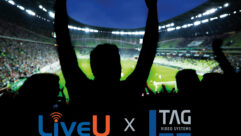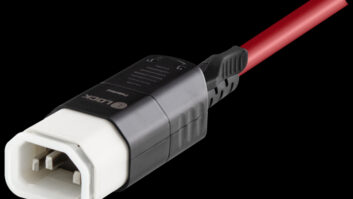The magic picture show: An overview of current and emerging video projectortechnology
Dec 1, 1997 12:00 PM,
Peter H. Putman
It used to be that choosing a video projector was a pretty cut-and-dry job.You either picked a three-gun CRT, a three-gun CRT or a three-gun CRT.About the only available options were the projector’s scan rate, the sizeof the CRTs and the mounting bracket. But all of that has changeddrastically in the past five years.
New technologies such as Hughes-JVC’s Image Light Amplifier (ILA) and TexasInstrument’s Digital Light Processing (DLP) have joined the fray, not tomention the avalanche of projectors based on liquid-crystal display (LCD)imaging engines. It is definitely not the same playing field anymore, andthat is all for the best.
What makes one technology better than another? Which is the best type ofprojector for a given application? Is there one across-the-board projectionsolution? What about price and performance overlap? These are all goodquestions that are best answered by a closer examination of each projectiontechnology.
CRT projectorsCRT projectors employ a variable-raster imaging process and are truly theold-timers of the projection industry. Today’s CRTs, however, are not yourfather’s projector. Advancements in microprocessor and random-access memorytechnology have made it possible to add features such as automaticconvergence, memory presets and serial port control. Other improvements inliquid-coupled lenses and improved bandwidth have helped CRT projectiontechnology remain the preferred choice for installations requiring precisecolor rendering, variable scan rates and flexible projection geometry.
On the downside, there is only so much energy that can be gleaned from acathode-ray tube, and designers and staging companies must often resort tostacking CRT projectors to get more light on the screen. This can be a realproblem when working in environments with high ambient light.
There is additional time and work involved to converge each projector inthe stack precisely, a daunting task even for experienced staging companies.
The good news is that prices have dropped considerably while set up andoperating procedures continue to get easier and easier. Today, $15,000 to$25,000 will buy a multiscan CRT projector with 50 to 100 scan rate/picturegeometry memories, 8 inch CRTs (20 cm), and dynamic convergence that can becontrolled from the infrared or hard-wired remote control. Horizontal scanrates and bandwidths on these projectors are high enough to supportresolutions exceeding 2,000 x 2,000 lines.
ILA projectorsThe image light amplifier was first developed by Hughes-JVC in the 1980sfor the United States Navy. It grew out of a need for a projector thatcombines all the benefits of a CRT design with more light output, whichsounded impossible at first. The trick was eventually accomplished bycombining the ILA device (a small liquid-crystal display with no “native”resolution), a 2 inch CRT (5 cm), and a xenon projection lamp.
The variable-raster image is written to a photo-conductive layer inside theILA device by the CRT, which is capable of displaying 2,000 lines ofdetail. Light from a xenon projection lamp passes through the front of theILA, is polarized, then reflects off the rear surface and travels back outthe projection lens, carrying the image with it. The result is a bright,high-contrast picture with high resolution and excellent color rendering.
Until recently, this high-brightness, high-quality image came with anequally high price tag. Early ILA projectors cost three to four times asmuch as conventional CRT models, weighing almost two hundred pounds andrequiring a great deal electrical power. In 1996, Hughes-JVC responded torequests for a single-lens design that cut down slightly on the physicalsize and used less power, but it still carried a hefty price tag of nearly$50,000.
LCD projectorsFive years ago, LCD imaging engines were unheard of in video, data andgraphics projectors. Today, however, LCDs are everywhere, having foundtheir way into portable, desktop, conference room and lightvalveprojectors. Initially hobbled by their fixed, native resolution, LCD panelsare now available in a variety of sizes. They are proving formidablecompetitors for CRT projectors when harnessed to metal-halide light sources.
There are many reasons for the rapid growth of the LCD projector market,but the most compelling is simplicity. Demand for a single-lens projectordesign with a basic control interface has pushed LCD projectors to thefront of the line for many large-screen display applications. Thanks tomore efficient polysilicon liquid crystal technology, LCD projectors haveimproved their light output considerably in recent years.
Another cause of increased demand for LCD projectors is the availability ofhigh-resolution LCD panels. Desktop and lightvalve models are now beingsold with 1,024 x 768 and 1280 x 1024 resolution panels, using electronicscaling to accomodate higher and lower resolution images. In addition,prices of LCD projectors have been volatile, with new models dropping incost by one-third to one-half a year after introduction. Desktop models canbe had for under $5,000, while higher-resolution portables are hoveringaround the $10,000 level. LCD lightvalves start at $15,000 and can cost asmuch as $125,000.
DLP projectorsThe first digital light processing projector made its appearance atINFOCOMM ’95, in the form of a 24-pound, desktop VGA/video model. Oftencalled the only “true” digital projection technology, DLP projectors useTexas Instrument’s patented Digital MicroMirror (DMD) devices to reflectlight, instead of transmit it as an LCD projector does. Grayscale imagesare formed by the amount of light reflected in each DMD, similar to thetiny printing dots that make up a screened photograph. DMDs resemble LCDsin that they also have a fixed, native resolution – currently, 848 x 600mirrors.
TI’s proprietary DLP imaging engines come in three flavors – single-chipwith a color wheel, two-chip with a color wheel, and three-chip withdichroic mirrors. Because of the size of the three-chip engine, its use hasbeen limited to lightvalve and conference room projectors. Two-chip designsare finding homes in large-screen retro video monitors, while thesingle-chip design is employed exclusively in the desktop projector market.
DLP technology, a slow starter in the desktop market so far, has beenpushed aside by LCD projectors thanks to the incredibly rapid advances inLCD resolution, projector form factors and light output. DLP projectorprices have not been quite as volatile as LCD models primarily because themajority of models offered the same features and used the same TI lightengines. Desktop models range in price from $8,000 to $10,000, whilethree-chip lightvalves cost from $45,000 to $90,000.
Looking down the roadAs of November 1997, the entire video/data/projection market is undergoinga tremendous change, and the eventual loser will probably be thetime-honored CRT projector. When LCD projectors gained market acceptance,they did it in the under-$10,000 market at the expense of older video-onlyand video/data CRT designs. Similarly, ILA and lightvalve LCD projectorshave gained a solid toehold in the $40,000 and up niche, at the expense of8-inch and 9-inch CRT projectors.
Single-chip DLP projectors were launched at just under $10,000 and haven’tmoved down in price much since then. Two-chip designs are just now comingto market in the form of 50 inch (126 cm) and 60 inch (151 cm) retrovideo/data monitors from Davis and Projectavision. Three-chip lightvalvesfrom Sony, Ampro, NEC, Electrohome and Digital Projection competehead-to-head with ILA and LCD models. About the only place where CRTprojectors could hold their ground was in the $10,000 to $40,000 category– until now.
One reason is Hughes-JVC, who recently announced two new versions of theirILA projector design. The first (Model 100) is aimed right at the high-end,9 inch (23 cm) CRT projector market. Carrying a $40,000 price tag, theModel 100 has a form factor closer to traditional CRT projectors, weighsjust over 150 pounds (?? kg) and offers the same resolution as thehigher-priced 300- and 200-series projectors. In essence, it offers all theadvantages of a CRT with much more light output — 1500 ANSI lumens, whichis about eight to ten times the light from a conventional CRT projector.
The second version (Model DLA-G10) uses a new version of Hughes-JVC’simaging engine called the D-ILA. Instead of a small CRT writing a rasterimage to an ILA’s liquid crystal, CMOS-addressing switches each of the1,365 x 1,024 individual pixels in the D-ILA on and off.
Because of the D-ILA’s ability to produce a high contrast, unused pixelsare as almost as dark as unlit portions of the screen. Hughes-JVC’s initialspecifications call for 1,000 lumens output in a 22 pound (?? kg) package,all for under $20,000.
Meanwhile, things have been heating up in Texas. TI is now shipping 1,024 x768 DLP chips to its anxiously waiting customers, who have been nervouslywatching market share slip to polysilicon LCD projectors. More importantly,TI has finally re-negotiated agreements with key projector manufacturers,permitting them to redesign TI’s various DLP imaging engines and making itpossible to reduce the size of portable and desktop projectors. At leastone manufacturer has already rolled out an under-10 pound (?? kg),single-chip SVGA DLP projector, and there are other manufacturers waitingin the wings for 1998.
At the high end of the market, the most powerful design to date comes fromDigital Projection, who has done a tremendous amount of work in gettingsuperior color rendering while retaining high brightness. DP’s Power 4dvproduces 3,500 ANSI lumens, while the power 5dV cranks out 5,000 ANSI. Bothprojectors use 848 x 600 DMD imaging chips and specially designed xenonlamps that are color-corrected for better spectral response in the red,orange and yellow parts of the color spectrum.
As usual, the LCD crowd isn’t standing still. At least four portableXGA-resolution polysilicon LCD projectors are now shipping to dealers.Three of them (ASK, Epson and In Focus) use the Epson 1,024 x 768 imagingengine, while Mitsubishi has its own design. For higher-brightnessapplications, Barco has been fitting 800 x 600 and 1024 x 768 LCD panelsinto their BarcoGraphics and BarcoData series projectors, and it showed theBarcoReality 9200LC at INFOCOMM ’97, which is claimed to produce 3,000lumens and produces crisp images using 1,280 x 1,024 LC panels.
Among the desktop and portable crowd, SVGA LCD projectors have pretty muchpushed VGA designs to the background. Virtually every SVGA projectorincorporates some form of image scaling to blow up 640 x 480 and video tofill the available pixels. Other improvements to LCD projectors includesealed light paths to improve image brightness and control dust along withmulti-lensed light integrators that resemble an insect’s compound eye.
Slugging it outWith so many competing technologies and cutthroat pricing, you’d think it asimple task to declare one or the other projection technology king of thehill. But that hasn’t happened yet simply because every customer has adifferent need, and there just isn’t a product out there that fits allthose needs. For instance, a real interesting battle will probably shape upin the desktop arena between high-resolution LCD imaging and the D-ILA -both of which use a fixed pixel structure and can accommodate 1,280 x 1,024resolution. Price may be the differentiator in this contest.
The workstation, conference room and auditorium markets are probably thelast bastion of CRT projectors, and they are about to come under attack byILA, DLP and LCD technology. While the ILA offers variable resolution,fixed-resolution LCD and DLP projectors will be helped considerably by anew technology — video scaling. Scalers up-size video (and alsolower-resolution computer displays) to match a given LCD or DLP projector’snative resolution. Depending on the manufacturer of the scaler, theconverted image can be remarkably sharp, crisp and free from artifacts.
Among the lightvalve crowd, the main concern is image brightness andcolorimetry. It’s likely that the only form of CRT technology to survivehere in the long term will be the ILA/CRT hybrid, which will be pittedagainst LCD and DLP technology. Potential customers for these productsinclude electronic cinemas, virtual reality rooms and theme parks, allplaces that might not have been able to use conventional CRT projection.
And the winner is…The truth is, a display with a native resolution of 1,280 x 1,024 can beused by more than 90% of the market for large-screen projection. There justaren’t that many potential customers working above this resolution.Assuming all the competing projection technologies can support at least1,280 x 1,024, the performance benchmarks will be (as they always havebeen) grayscale capacity, color rendering, resolution and brightness.
For flat-screen displays, the long-term goal will be producing imagescomparable in quality to variable-resolution systems. Forvariable-resolution projectors, the long-term goal is a reduction inphysical size. For both flat-screen and variable-resolution projectors, thefinal arbiter will be (surprise!) price. Want to place your bets?










